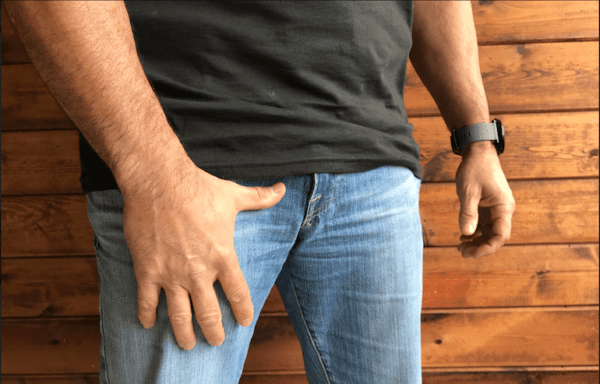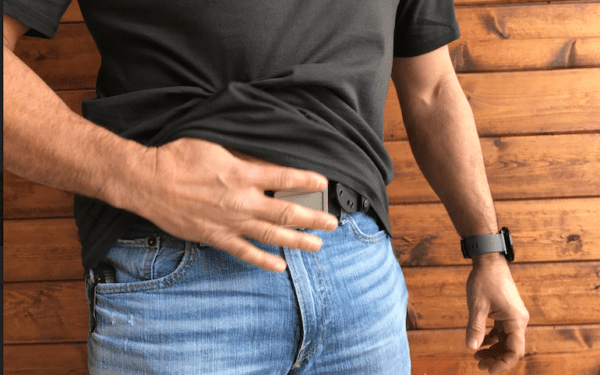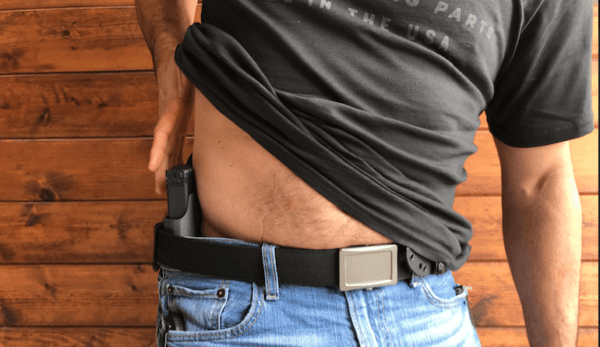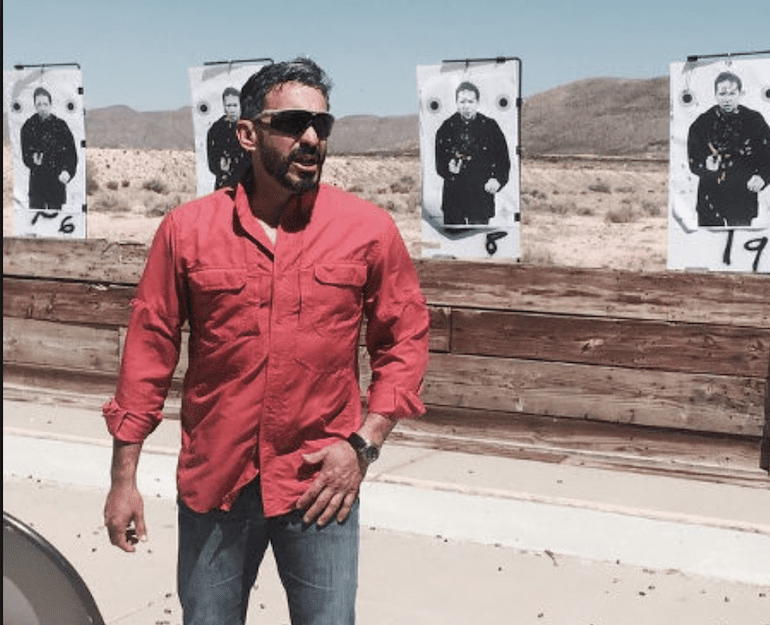During a potentially lethal encounter, your life may well depend on how quickly and efficiently you can get to your gun. “Defeating” your cover garment — moving it out of the way to bring your weapon to bear on a threat of grievous bodily harm or death — is your first priority. To get it right, you need to think ahead and practice . . .
Painted into a corner
When it comes to clothing choices, a lot of concealed carriers take the path of least resistance — and stay on it for life. They wear the same basic set-up all the time, whether it’s a polo shirt draped over an outside-the-waistband holster, a pair of one-size-too-big jeans hiding an inside-the-waistband holster, or a particular leather jacket covering a gun stashed at the 6 o’clock position.
If you’re a concealed carrier who wears a garment until it falls apart, I’m talking to you.
Problem 1: at some point your “uniform” will seem out-of-place. It will attract attention or focus. Which is not as big a problem as 2: at some point, you’ll wear something different. You won’t able to draw your gun quickly or efficiently.
One Draw Fits All?
Early in my career, traveling all over the globe, I had to wear all kinds of different clothes, for all kinds of different climates, in all kinds of different social or work settings. If push came to shove, I had to be ready to draw, no matter what.
I played around with a lot of techniques. I settled on one with the highest success ratio, regardless of the garment. It works no matter what I’m wearing: a T-shirt, polo, dress shirt, suit, sports coat or jacket.
Attack your base
First rule: always attack/defeat the base garment. In cold weather, wearing multiple layers, attacking the base ensures that the rest are defeated. Second rule (of thumb): use your thumb.

First place your hand on your gunside leg. Hold your thumb held horizontally.

Next, hook your thumb under your cover garment(s). Turn it vertically (facing up) and pull your hand and the garment up, clearing the garment away from the holstered defensive pistol.

Lastly, as you hand rises up, grab your pistol. Draw and fire.
A lot of gun gurus will teach you to use your non-shooting hand to clear the garment, followed by your strong hand to secure your gun and fire. That can work too, and quickly.
But the two-handed technique doesn’t work well with a wide range of clothing choices or holster positions. Crucially, it also ties up both hands — preventing you from using your “weak” hand to block, push, grab or strike your opponent. And it stops you from pulling a friendly out of the way or towards escape.
Practice
I’m not saying the thumb hook technique is the easiest draw from concealment. It may not even be the fastest. But I am saying it’s the most versatile.
Once mastered, it’s a technique you can use wearing a wide variety of clothing and holsters. Instinctively. And that, my friends, is the name of the game.
Jeff Gonzales is a former US. Navy SEAL and preeminent weapons and tactics instructor. He brings his Naval Special Warfare mindset, operational success and lessons learned unapologetically to the world at large. Currently he is the Director of Training at The Range at Austin. Learn more about his passion and what he does at therangeuastin.com.





For me, I find it too easy to miss the thumb under the garment, especially under stress.
My technique is to grab the garment with my whole hand and proceed as Jeff stated
Definitely use a one-handed draw stroke for the reasons Jeff described.
Yup, same here. Thumb is too easy to miss. I grab straight up with four fingers, then transition to thumb out once the garment is at its highest point for the draw.
The hardest part, really, is finding a range you can draw and shoot, and shoot fast. Yes I’m aware, dry fire at home. It’s good, but I’d sure like to train as realistcly as possible when I can shoot live rounds.
Depending on your neighborhood, practice with Red Jets or rubber bullets. They are at least primer fired and if you shoot yourself in the leg, ornamental their parts, it will sting but that’s it. You can then add some powder to increase the velocity. Good practice before you go to the sticks and shoot your nards off.
Do you do force on force with real weapons? I have only done that in the service and the precautions are significant. It’s an interesting idea and beats airsoft or paintball
Good to know. I actually could use those at home where I live.
Where do you live, in most southern cities dynamic ranges are popping up. In the San Antonio/ Austin area there are a number of maneuver bays available at local ranges. You will pay more than the standard range fee but the training value is high.
That’s why it’s worth one’s while to have local access to some private property where one can train as one pleases…
I live in north Florida. I actually haven’t heard of these. I will have to look into it. I will pay more for a decent range you can realistically train at. That’s one of my biggest desires in life.
Hank,
How long would it take you to drive to Apalachicola, Osceola, or Ocala National Forests? Once you are there, choose a secluded, suitable location where you can practice drawing and shooting.
Make a day of it if you like. Hike a bit and get some exercise. Look for wild edibles and improve your survival skills while you are at it. Maybe even find a location that would be great for camping. Better yet, make it a point to go camping and practice your marksmanship at your campsite.
You are right that it is difficult to find a range that will allow drawing from the holster
There is a seedy run down range here in south Florida called Revere Range that allows drawing in one lane
That lane has bullet holes in the floor, in the half door and on the ceiling
It seems that a lot of people need to practice their draw!
I live 5 minutes from Delray Shooting Center. Been there 2x. Shooters Emporium when it was open was 1st choice originally. But I go out of my way to get to Revere. It may be a run down out of condition range where the lane you use depends on what caliber your have at the time.. Ive been going there since the mid 90s. Before Eileen and it was a crap hole then. But a great place to shoot in the dark.
That’s crazy! I have had a lot of draw and fire practice, because I found private property early on in my shooting adventures.
And I dry fire practiced a lot. I’ve never shot anything except the target I was aiming at. 90% of my draw practice has been from the pocket because that’s how I carry 90% of the time.
I’ve used this technique since I’ve started carrying with one minor difference. In the pictures it appears he hooks his thumb under the front of his shirt and slides it around to the back. I hook my thumb right next to my gun and lift there. The reason for that is i carry iwb by my back right pocket, where many men carry their wallets. If I were to be mugged, reaching for my gun would appear to a mugger as if I were cooperating, reaching for my wallet. It would offer that much more time before he would realize I was armed, hopefully increasing my chances for a successful dgu.
You folks are making me feel old . I’ve dressed around my ‘Jackass Rigged’ 1911 with two spare mags on the strong side for more years than I want to count .
Doing work on my 100 acre farm , walking a daughter down the isle on her wedding day , going to ‘WallyWorld’ for a whim .
Same ,Same .
Cops don’t notice it , even when asked to check , and one hand will deploy it .
Only takes a short moment to deploy a second hand if more shots are needed .
Shooting voles from the seat of a moving farm tractor ‘one handed’ is good practice .
You must have a pretty large chest size if you can carry a 1911 horizontally. I’ll admit I’m working on one myself.
The 1911 or the chest size ? I’m 67 years old and never been a second place winner . Us old folk are not to be messed with .
We tend to be intolerant .
James,
I did not understand your comment and I am unable to picture how you carry your 1911. Can you provide a more detailed explanation with generic words?
Do you carry your 1911 in a shoulder holster? If so, does the holster hold it horizontally pointing behind you or vertically pointing down?
Do you just stuff your 1911 in your pants pointing down? Or do you stash it in a holster on your belt? At what location around your waist do you keep your gun/holster?
Never mind. I looked up a “Jackass rig” thinking that might be a shoulder holster and found exactly that.
When James said that he carried a “jackass rigged” 1911, I thought that term (jackass rigged) might mean carried in a particular, unwise fashion like “Mexican carry”.
Nice appendectomy scar there. Was that intentional or have you sworn off AIWB carry now?
9 out of 10 Shoulder Holster wearers surveyed say “Stop digging in your drawers”. The 10th one’s tired of tellin ya.
; )
Yup, Kangaroo Carry for the win!
The author’s advice is of marginal use in climes where average wintertime high temperature is below freezing.
I only have one arm, I evolved into this very technique with trying different approaches, necessity is the mother of invention as well as solutions converge on the logical, and I live in Wisconsin, spent 10 of the last 14 days with below 0 days.
Cold weather also tends to thin out bad guys.
Comments are closed.